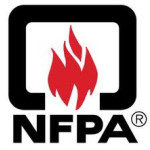- Industrie: Fire safety
- Number of terms: 98780
- Number of blossaries: 0
- Company Profile:
Established in 1896, NFPA's mission is to reduce the worldwide burden of fire and other hazards on the quality of life by providing and advocating consensus codes and standards, research, training, and education.
A commercial, industrial, or institutional appliance needing a chimney capable of withstanding a continuous flue gas temperature not exceeding 1400°F (760°C).
Industry:Fire safety
A commercial, industrial, or institutional appliance needing a chimney capable of withstanding a continuous flue gas temperature not exceeding 1000°F (538°C).
Industry:Fire safety
A commercial, industrial, or institutional appliance needing a chimney capable of withstanding a continuous flue gas temperature exceeding 1800°F (982°C).
Industry:Fire safety
A combustion system in which the burner(s) directly heats volatile organic compounds (VOCs) or hydrocarbons (HCs) to the destruction temperature, prior to their introduction to a destruction catalyst, without heat recovery to the incoming gases, and in which the catalytic destruction temperature is lower than the non-catalytic (direct thermal) destruction temperature.
Industry:Fire safety
A combustion system in which the burner(s) directly heats VOCs or HCs to the destruction temperature without heat recovery to the incoming gases.
Industry:Fire safety
A combustion system in which the burner(s) directly heats VOCs or HCs to the catalytic destruction temperature prior to their introduction to a destruction catalyst, after which products of combustion are used to indirectly heat the incoming gas stream before it contacts the burner flame, and in which the catalytic destruction temperature is lower than the non-catalytic (direct thermal) destruction temperature.
Industry:Fire safety
A combustion system in which the burner(s) directly heats VOCs or HCs after the gas stream is preheated to the destruction temperature by the periodic flow reversal of the gas stream through beds of ceramic heat recovery media with a coating or layer of catalyst that are alternately heated by the product gases during an exhaust cycle and then have given up their heat to the incoming reactant gases during an inlet cycle.
Industry:Fire safety
A combustion device in which the burner(s) directly heats VOCs or HCs to the destruction temperature and in which the hot products of combustion are used to indirectly heat the incoming gas stream before it contacts the burner flame.
Industry:Fire safety
A combustion device in which the burner(s) directly heats VOCs or HCs after the gas stream is preheated to the destruction temperature by the periodic flow reversal of the gas stream through heat storage media that alternately have been heated by the product gases during an exhaust cycle and then have given up their heat to the incoming reactant gases during an inlet cycle.
Industry:Fire safety
A combustible that is capable of easily being ignited and rapidly consumed by fire.
Industry:Fire safety
